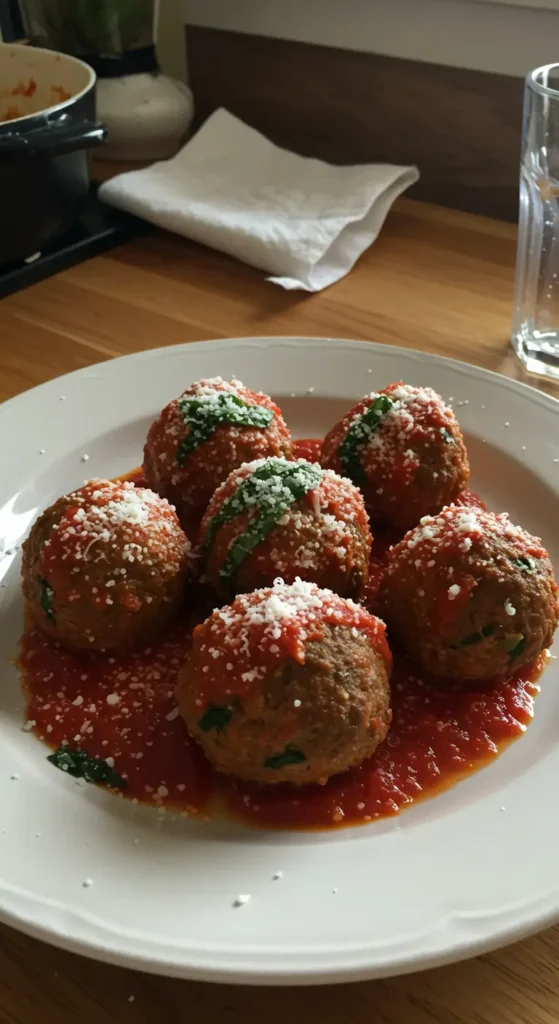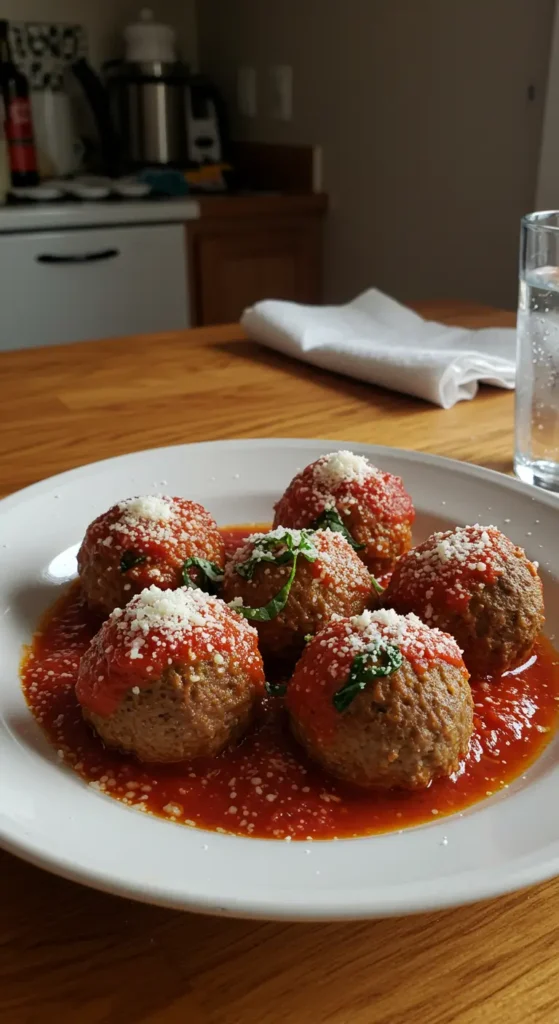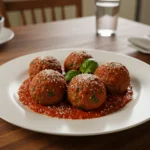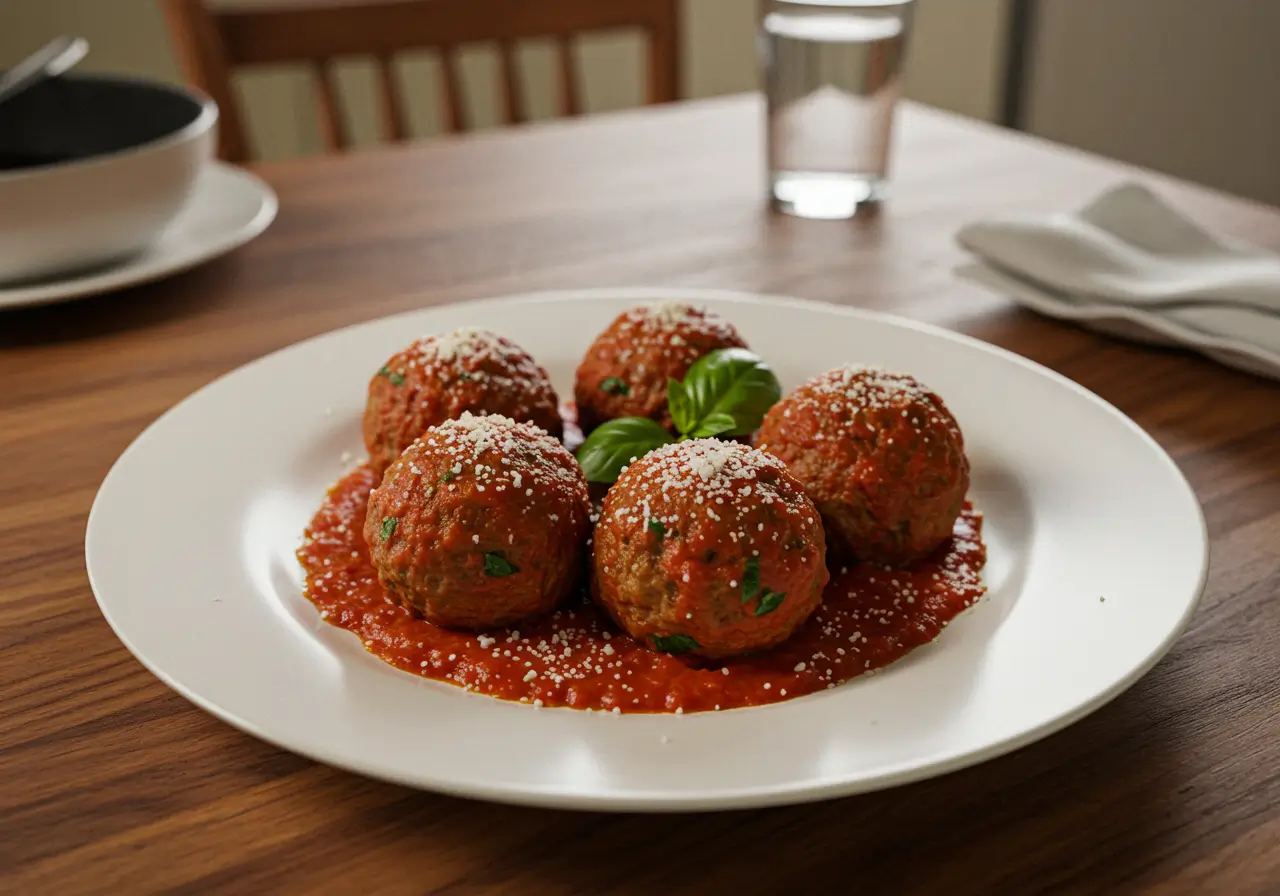Classic Homemade Meatballs
Table of Contents
Everyone loves a good meatball — especially when it’s made from scratch with love, tradition, and a little kitchen magic. In this guide, we’re diving deep into the art of making Classic Homemade Meatballs. From picking the perfect meat combo to shaping, cooking, and serving, we’re leaving no breadcrumb behind. Whether you’re a seasoned cook or just stepping into the kitchen, this article will walk you through everything you need to whip up meatballs that are tender, juicy, and full of flavor.
Oh, and we’re not stopping at just cooking! You’ll also get time-saving tips, storage hacks, common mistake fixes, and answers to burning questions everyone’s asking about this comfort food classic.
Ingredients Matter – Choosing the Right Components

Best Meats for Classic Homemade Meatballs
When it comes to Classic Homemade Meatballs, meat choice can make or break your dish. While ground beef is a must-have for its rich flavor, blending it with ground pork adds just the right amount of fat for moisture and taste. If you’re aiming for extra tenderness, toss in a little veal — but only if it fits your preferences.
Don’t go lean here — a little fat keeps things juicy. Ideally, aim for a 70/30 beef-to-fat ratio. Why? Because dry meatballs are a heartbreak no one deserves. Stick with quality meat and your meatballs will practically melt in your mouth.
Breadcrumbs, Cheese, and Herbs: Flavor Builders
Now let’s talk about those mighty little ingredients that give Classic Homemade Meatballs their signature punch. First up: breadcrumbs. Use fresh breadcrumbs if you can — they soak up moisture better than dry, store-bought ones. But if you’re in a pinch, unseasoned panko works well too.
Cheese isn’t just a topping here — it’s a star player. A good helping of Parmesan or Pecorino Romano brings salty depth and umami magic. Pair that with finely chopped parsley or basil for a fresh herbal lift that balances out the richness.
Eggs and Milk: Binding Agents Explained
Think of eggs and milk as the glue in this culinary masterpiece. The eggs bind everything together, while the milk softens the breadcrumbs. This combo ensures your meatballs are moist and tender, never rubbery. But don’t go overboard — too many eggs and you’ll end up with a dense meatball, not a fluffy one. A good rule of thumb? One egg per pound of meat.
Step-by-Step Guide to Making Classic Meatballs

Prepping Your Ingredients Efficiently
Before you even touch the meat, get everything else ready. Trust us — a little prep goes a long way. Chop your garlic, herbs, and onions (if using) ahead of time. Soak your breadcrumbs in milk and let them sit while you grate your cheese. It all comes together faster — and smoother — when the prep work is solid.
By laying out your ingredients beforehand, you keep the mixing clean and avoid overworking the meat. And remember: the more organized your kitchen, the more enjoyable the process.
How to Mix Without Overworking
Here’s a golden rule for Classic Homemade Meatballs: don’t overmix! Use your hands or a large fork to gently fold the ingredients together until they’re just combined. Mixing too much can lead to tough, dense meatballs — and no one wants that.
Start with the breadcrumb mixture, cheese, and seasoning. Mix these into the meat in batches, gently turning everything until it’s just blended. You want texture and pockets of flavor, not a meat paste. If you’re using a stand mixer, use the lowest speed and stop as soon as it comes together.
Shaping Like a Pro: Uniformity & Size Tips
Size matters — at least when it comes to meatballs. Too big, and they’ll take forever to cook. Too small, and they might dry out. Aim for golf-ball size or use a ¼-cup scoop to keep things consistent.
Roll them gently between your palms, but don’t compress them too tightly. A slightly craggy texture actually holds onto sauce better. And if they’re not perfectly round? That’s okay. Rustic is real, and imperfections add charm.
Once shaped, you can chill the meatballs for 15–20 minutes before cooking. It helps them firm up and keeps them from falling apart in the pan or oven.
Cooking Methods – Which One’s Best?
Baking vs. Pan-Frying vs. Broiling
When it comes to cooking Classic Homemade Meatballs, there’s no one-size-fits-all approach. Each method brings something unique to the table.
Baking is the go-to for ease and consistency. It’s hands-off and perfect when you’re cooking for a crowd. Just pop them in a 425°F oven for 20–25 minutes until they’re golden and cooked through. This method also helps keep the meatballs from drying out, especially when placed on a lightly greased baking rack.
Pan-frying, on the other hand, gives you those crisp, caramelized edges. But beware — it takes more attention and time, especially if you’re frying batch after batch. However, the flavor payoff is worth it if you’re going for that rustic, home-style vibe.
Broiling is fast and intense. Great for a quick char and browning, but it’s a little trickier to control. If you’re in a hurry and want that crispy finish, give it a shot — just don’t step away from the oven!
How to Cook Meatballs in Sauce Without Overcooking
Simmering meatballs in sauce isn’t just convenient — it’s a flavor booster. After browning, gently drop the meatballs into a pot of homemade marinara or your favorite tomato sauce. Let them simmer for 10–15 minutes until fully cooked and infused with flavor.
But here’s the catch — don’t overcook them. Too long in the sauce, and they’ll toughen up. Keep the simmer low and the lid slightly ajar to avoid a boiling frenzy.
Sauce Pairings & Serving Ideas
Classic Marinara and Other Sauce Options
You simply can’t go wrong with marinara — it’s the soulmate of Classic Homemade Meatballs. Rich, tomato-based, and seasoned with garlic, basil, and a hint of red pepper, this sauce brings out every savory note in the meat.
Serving Suggestions: Pasta, Subs, or Solo
Of course, spaghetti is a no-brainer — it’s the classic pairing. But meatballs shine in other dishes too. Pile them into a toasty sub roll, smothered in sauce and melted provolone, and you’ve got the ultimate comfort sandwich.
Hosting a party? Serve mini meatballs with toothpicks and dipping sauce for an easy crowd-pleaser. And if you’re keeping it low-carb, toss them on a bed of sautéed zucchini noodles or roasted veggies.
For more delicious recipes that pair beautifully with meatballs — like crusty bread or comforting soups — check out this homemade garlic bread recipe. 🍞🧄
Make-Ahead, Freezing, and Reheating Tips
How to Freeze Meatballs Without Losing Flavor
Sometimes, the best meals are the ones you made last week. That’s right — Classic Homemade Meatballs freeze beautifully, so you can always have them ready to go. Just make sure they’re fully cooked first. Then, let them cool completely.
Next, arrange the meatballs on a baking sheet in a single layer and freeze until solid — about 1–2 hours. After that, pop them into an airtight container or freezer bag. They’ll stay fresh for up to 3 months.
Reheating Methods That Keep Them Juicy
No one wants dry, rubbery leftovers — yikes. To reheat frozen meatballs, you’ve got options. For best results, simmer them gently in sauce over low heat until warmed through. Or, bake them at 350°F for 15–20 minutes covered with foil to trap moisture.
Microwaving is okay in a pinch, but be careful. Use medium power and add a splash of water or sauce to avoid drying them out.
Common Mistakes and Fixes
Why Your Meatballs Might Be Dry
Dry meatballs? That’s the heartbreak hotel of Italian cooking. But don’t worry — it’s usually an easy fix. If your Classic Homemade Meatballs are lacking moisture, odds are you used lean meat or skipped soaking the breadcrumbs.
Remember, fat equals flavor and moisture. Always use meat with a little fat, and soak those crumbs in milk like your nonna would.
How to Fix Crumbly or Tough Meatballs
Meatballs falling apart? That’s frustrating — but totally fixable. The culprit? Usually not enough binding or overmixing. Eggs and soaked breadcrumbs are key. If the mixture feels too dry, add a splash more milk.
Now, if they’re turning out tough? You’re likely overmixing or overcooking them. Go easy when combining ingredients, and keep an eye on your cooking time. Less is more when it comes to mixing — your meatballs will thank you.
Print
Classic Homemade Meatballs
- Total Time: PT35M
- Yield: Serves 4
- Diet: Halal
Description
Classic Homemade Meatballs are juicy, tender, and packed with Italian flavor. Made with a blend of beef and pork, fresh breadcrumbs, Parmesan cheese, and herbs, this family-favorite recipe is perfect for pasta, subs, or enjoyed on their own. Easy to make, freezer-friendly, and guaranteed to be a crowd-pleaser.
Ingredients
- ½ cup fresh breadcrumbs (from 1–2 slices white bread, crusts removed)
- ¼ cup whole milk
- 2 egg yolks
- ½ cup grated Parmesan or Pecorino Romano cheese
- 2 garlic cloves, finely chopped
- 1 tsp salt (or 2 tsp Diamond kosher salt)
- 1 tsp ground black pepper
- 1 lb ground beef (preferably 70/30)
- 1 lb ground pork
- ¼ cup grated onion (optional)
- ⅓ cup chopped parsley or basil
- Olive oil (for frying or coating the baking sheet)
Instructions
- Soak the breadcrumbs in milk for 5 minutes in a small bowl.
- Add egg yolks, cheese, garlic, salt, and pepper to the breadcrumb mixture. Mix into a coarse paste.
- In a large bowl, combine ground beef, pork, and optional onion. Add in the breadcrumb mixture and herbs. Mix gently until combined.
- Use a ¼-cup scoop to portion the meat and roll into evenly sized balls.
- To bake: Preheat oven to 425°F, place meatballs on an oiled baking sheet, bake for 10 minutes, flip, and continue baking for another 10–12 minutes until browned.
- To pan-fry: Heat olive oil in a skillet over medium-high. Brown meatballs on all sides, then reduce heat, cover, and cook for about 10–12 minutes until done.
- To cook in sauce: After browning, place meatballs in simmering marinara sauce and cook for 10–15 minutes on low heat.
Notes
- Use fresh breadcrumbs for softer texture, or unseasoned panko if needed.
- For a leaner version, substitute turkey or chicken for pork.
- Let the meatball mixture rest before shaping to enhance flavor and texture.
- Chill shaped meatballs before cooking to help them hold their shape better.
- Prep Time: PT15M
- Cook Time: PT20M
- Category: Lunch, Dinner
- Method: Baking, Pan-Frying, Simmering
- Cuisine: Italian-American
Nutrition
- Serving Size: 1 serving (approx. 4 meatballs)
- Calories: 430
- Sugar: 1g
- Sodium: 560mg
- Fat: 30g
- Saturated Fat: 10g
- Unsaturated Fat: 16g
- Trans Fat: 0.5g
- Carbohydrates: 5g
- Fiber: 0.5g
- Protein: 25g
- Cholesterol: 105mg
Keywords: classic homemade meatballs, traditional Italian meatballs, easy meatball recipe, juicy meatballs, homemade meatballs from scratch, best meatball recipe
FAQs About Classic Homemade Meatballs
Do I need to use fresh breadcrumbs?
Not at all — but they do make a difference. Fresh breadcrumbs soaked in milk add more moisture, which helps keep your Classic Homemade Meatballs light and juicy. If you’re short on time, unseasoned panko is a decent backup.
What’s the best meat combo?
A mix of ground beef and pork is your safest bet. The beef brings that meaty richness, while pork adds fat and flavor. For a touch of tenderness, toss in some ground veal if you’d like.
Can I cook them straight in the sauce?
Yes, but brown them first! Searing seals in the flavor and helps them hold their shape while simmering.
Are meatballs better the next day?
Honestly? Yes! As they rest, flavors deepen and textures mellow — making next-day Classic Homemade Meatballs even tastier.

